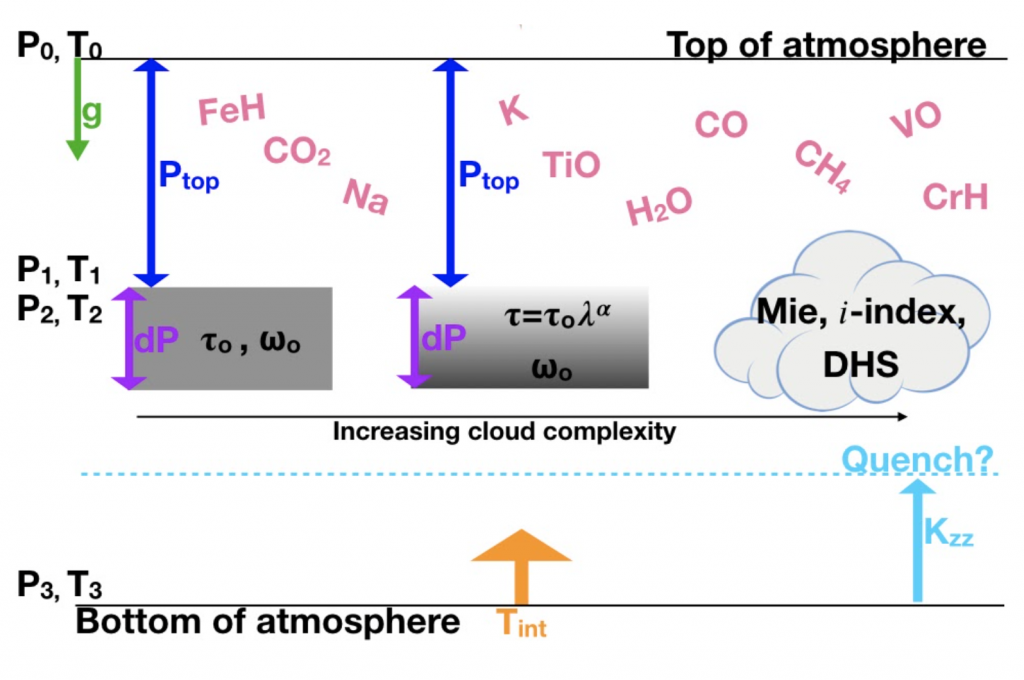The BDNYC team’s project proposal entitled “Read Between the Lines: Determining Atmosphere and Bulk Compositions for Planetary Mass Objects Using Spectral Retrievals” was selected for a NASA Exoplanets Research Program (XRP) grant.

Parameters to consider in spectral retrievals of directly-imaged exoplanet atmospheres. These include a parameterized P-T profile, gas species (pink), various cloud models (center grey), and a disequilibrium chemistry option (aqua).
NASA’s XRP program solicits basic research proposals to conduct scientific investigations focused on exoplanets and exoplanetary systems. The broad research objectives of XRP include, but are not limited to: the detection and characterization of exoplanetary systems; the characterization of individual exoplanets; and the study of the origins of exoplanets.
BDNYC’s project proposal is a collaboration between the team based at AMNH (led by PI Jackie Faherty), the team based at Cornell University, (led by Science PI and former BDNYC graduate student Eileen Gonzales), and the team based at the University of Hertfordshire, (led by Co-I Ben Burnigham). The proposal is focused on an examination and recalibration of atmospheric retrieval codes, which will be crucial for planning and interpreting the forthcoming wealth of directly-imaged exoplanet and analogous brown dwarf spectra data from the James Webb Space Telescope (JWST).
Atmospheric retrievals were originally developed to handle mission data for solar system planets and then modified to tackle transmission and emission spectroscopy of extrasolar worlds. Over the last decade, nearly 30 retrieval codes have been developed to characterize exoplanet atmospheres via thermal emission, transmission, and reflected light spectra.
However, retrieval codes are rarely compared and most are proprietary, often leading to different results in the literature when analyzing the same spectrum. Each code uses different assumptions and approaches, such as different opacity databases, P-T profile parameterizations, and cloud treatments. These varying assumptions can significantly impact the resultant atmospheric properties derived, especially for high signal-to-noise datasets. Without standardized retrieval codes, it will be impossible for scientists to ensure that reliable atmospheric properties are derived from interpreting JWST data.
The selected NASA XRP Grant will enable BDNYC to assemble a team of exoplanet and brown dwarf experts to perform a critical examination of underlying retrieval assumptions. The BDNYC team will carry out this examination by exploring the impact various assumptions and approaches have on retrieved properties using synthetic data with three different retrieval codes, then apply their findings to a sample of 10 objects inclusive of directly imaged exoplanets and their analogous Teff brown dwarfs, decoupling temperature, gravity, composition, and cloud properties for all objects. The team will go on to compare and contrast the results between retrieval codes to develop a best practice for interpretation and formulation, and complete an investigation of the diversity in thermal structure, cloud properties, and intrinsic composition (e.g. C/O ratio) of the sample to glean insights into what formation mechanisms are at play among the objects.
The project will result in a guided data challenge based on the found benchmark sample. The BDNYC team will encourage other teams with retrieval codes to compare and contrast their results, thereby ensuring more reliable, large-scale interpretation of exoplanet direct imaging studies with JWST and Roman.
